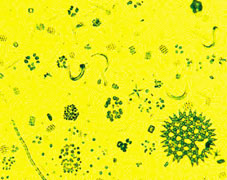|
ERCIM News No.49, April 2002
|
Phytoplankton Dynamics - the Struggle for Light
by Ben Sommeijer
A fairly realistic mathematical model describing the dynamics of phytoplankton was developed at CWI jointly with the research group on Aquatic Microbiology at the University of Amsterdam. One result negates a recent idea to reduce two environmental problems in one action.
The idea seemed attractive. Collect our scrap iron, and feed it to the tiny organisms in the oceans called phytoplankton. They love it and their population will grow on it. They love carbon dioxide too, extracting it from the atmosphere (the present intake is several gigatons per year). This carbon is transported downward by sinking phytoplankton species, and will eventually end up 'in the deep bosom of the ocean buried' - a mechanism called 'Biological Pump' (Figure 1) . Thus two birds would be killed with one stone: disposal of industrial waste and reduction of the greenhouse effect. Alas, the idea lasted as long as it remained qualitative. One of the studies with the mathematical model concerned, which is fairly realistic because it incorporates the most essential mechanisms, explains the recent field observation that iron fertilization fails to enhance carbon export to the deep ocean.
 |
Figure 1: |
 |
Figure 2. |
Phytoplankton is a generic name for a great variety of micro-organisms (algae) that live in lakes and oceans. Modelling its dynamics is of great interest, since phytoplankton provides the basis of the food chain. Phytoplankton requires light for photosynthesis. In a water column, light intensity decreases with depth, due to absorption. As a result, the phytoplankton production rate, which is determined by the local light intensity, decreases with depth. Furthermore, mortality rates and transport by turbulent diffusion in a water column (mixing) play a role. Also, phytoplankton species often have a specific weight different from that of water, giving rise to vertical transport in the form of sinking or buoyancy. All these processes are incorporated in an integro-partial differential equation of advection-diffusion-reaction type describing the population dynamics of phytoplankton. On the basis of this model we developed both analytical and numerical tools for several studies. One result is that the long term survival of a particular phytoplankton species ('bloom development') crucially depends on the mixing rate, the water column depth and the vertical velocity. Another result is that the maximal sinking velocity of phytoplankton that can be sustained is inversely proportional to the water turbidity. Hence the downward flux of phytoplankton biomass is very different for clear and for turbid water, explaining why iron fertilization does not enhance downward carbon transport (Figure 1). Since there are thousands of different phytoplankton species, slowly drifting in lakes and oceans (Figure 2), a natural extension of the model is to systems in which various species are competing. Buoyant species seem to have an advantage over sinking species since they can easily reside in the well-lit upper zone close to the water surface, and hence capture a lot of light. Moreover, they have the additional advantage to shade other species at deeper levels. Nevertheless, as it turns out, the balance between survival and death for the various species is very delicate and depends on values of other parameters as well, such as background turbidity, incident light intensity, and specific light attenuation coefficients of the different species.
Link:
http://www.cwi.nl/projects/plankton
Please contact:
Ben Sommeijer, CWI
Tel: +31 20 592 4192
E-mail: B.P.Sommeijer@cwi.nl
